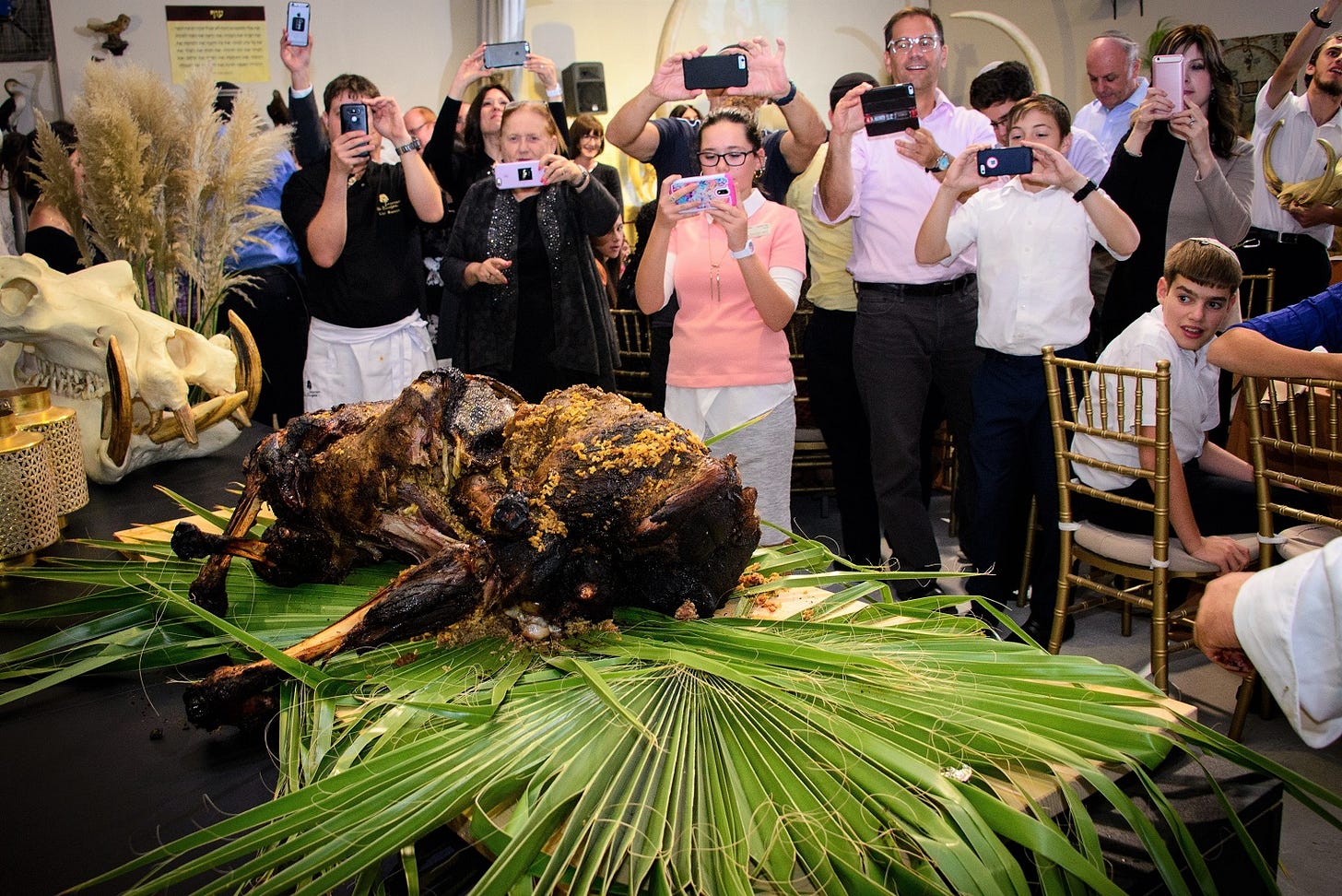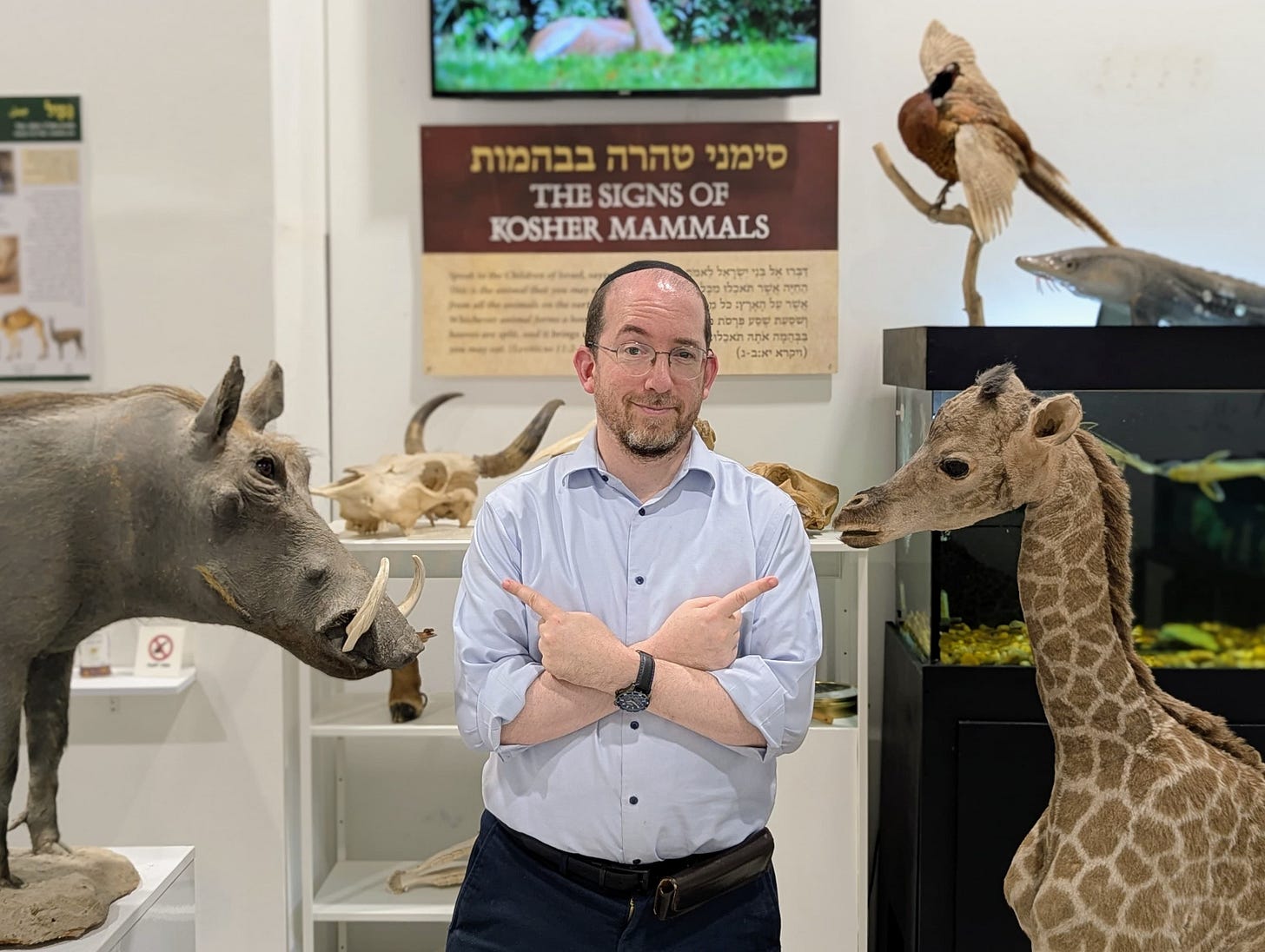Is it a Mitzvah to Eat Kosher?
It's not so simple
(Scroll down to learn about a new video available for purchase!)
We normally think of it being a mitzvah to eat kosher food. But for those who are interested in the technicalities of Torah law, it’s surprisingly difficult to define this mitzvah. Does one fulfill a positive mitzvah by eating animals that are kosher? Or is it instead that you commit a sin by eating animals that are not kosher? Do you get a mitzvah every time you take a bite of peacock or piranha, or is it that you get a sin if you eat pork or pufferfish - or is the mitzvah something else altogether?
In this week’s Torah portion of Shemini, God declares, “This is the animal that you may eat…” and proceeds to define which mammals, fish, birds and insects are kosher and non-kosher. But is one thereby fulfulling this as a positive commandment with every bite of schnitzel? And what if a person happens to be vegetarian?
Rambam, in Sefer HaMitzvos, has a curious formulation. He states that the positive commandment is to actually check the signs of kosher land animals, birds, fish and insects. (Sefer HaChinnuch goes even further, stating that if you eat an animal without checking for all the signs, then even if it was actually kosher, you have transgressed a commandment.)
But how would that relate to us, since we buy food at stores? My son’s rosh yeshiva Rav Weizman, before giving a symbolic explanation of this law, notes that as long as somebody has checked the animal’s signs then you don’t contravene this prohibition. Yet this wouldn’t seem to help. Nobody actually checks each cow to see if it chews the cud. And nobody is checking the legs on every kosher locust that we sell at the Biblical Museum of Natural History! And is there a way to fulfill this mitzvah without having to actually eat locusts, seeing as many people are locust intolerant?
Rav Asher Weiss argues that Rambam in Sefer HaMitzvos has to be reinterpreted in light of his very different formulation in the Mishneh Torah. There, Rambam states (at least according to some textual versions) that it is a mitzvah to know how to differentiate between kosher and non-kosher animals.
Still, even within this definition, there is still further clarification needed. Rav Weiss explains Rambam to mean simply that we must conduct ourselves according to the kosher laws, taking pains to only eat kosher creatures (which can be done by only buying foods with rabbinic certification). But several authorities explain Rambam to mean that the mitzvah is for a person to be proficient in how to tell apart kosher animals from non-kosher animals (even if you don’t actually eat them).
Rav Weiss does not agree with this view, as he does not see a reason why kashrut, of all mitzvot, would uniquely require such a level of knowledge. But I can think of two reasons. One is that it is valuable to be self-reliant, in case we end up in a situation where one cannot rely upon others. The second is that there can be significance to understanding why certain species are kosher and others are not.
How is a person supposed to go about becoming proficient in knowing how to tell apart kosher and non-kosher creatures? Fortunately, the Hall of Kosher Classification at the Biblical Museum of Natural History perfectly and uniquely suits this purpose. But I recently realized that many people don’t get to visit the museum, and even those who do usually only have time for a taste (metaphorically speaking) of the exhibits.
And so we just filmed an hour-long in-depth tour of this hall, which you can purchase for download on the museum website. Do so today and not only will you fulfill a positive commandment according to most interpretations of Rambam, but you’ll also have some great insights to share at the Shabbos table! You can download the video at this link. Meanwhile, if you’re wondering about our legendary exotic kosher feasts, we are planning one for July in Los Angeles and December at the museum. Stay tuned!






Just to mention currently I am in Oaxaca, Mexico. Grasshoppers are a common snack, and they are considered part of Oaxaca's cultural cuisine. There are people selling varieties of grasshoppers all over the markets. Flying ants (in season) are also part of Oaxaca's culinary culture, as they are made into a sauce which I am told has 'an earthy flavor'. People often ask me if they are kosher, and I do believe the answer is yes (although I'm not certain, Natan if you have any information please add.) But I personally can't bring myself to try these things, it just doesn't feel right to me to eat.
Mitzvah or not, it helps us who do it.